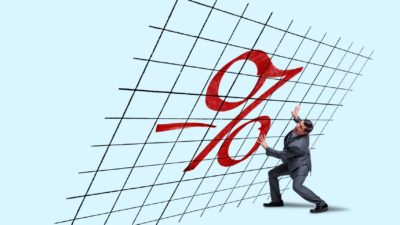Interest rates could stay low "for decades" according to Reserve Bank of Australia (RBA) governor Philip Lowe. As reported in The Australian, Lowe told the Australia-Canada Economic Leadership Forum, "it's quite likely we're going to be in this world of low interest rates for years, perhaps decades, because it's driven by structural factors in the global economy."
Rates declining for past decade
The cash rate is at a record low of 0.75% following 3 cuts in 2019. Interest rates have been in slow decline over the last decade as the RBA has pushed to increase employment and lift inflation into the 2–3% target band. Low rates have been a boon for borrowers, but savers have been effectively penalised as returns dwindle, encouraging a move into riskier assets in the search for yield.
Impact on borrowers
Highly geared consumers have been rewarded with successive rate cuts. In theory this should stimulate the economy by decreasing the cost of servicing debt for indebted households, leaving them with more to spend. There is a risk, however, that consumers end up even more highly geared as cheap credit encourages additional borrowing.
As Lowe acknowledged in a statement last October, "lower rates . . . did help people repair their balance sheets and pay their debt off more quickly, but perhaps we're moving to a point where lower rates are encouraging people to borrow even more, which could create vulnerability down the track."
According to a 2018 report, the availability of cheap credit has helped push up house prices which have increased 42.8% nationally over the last decade. Prices in Melbourne are up 72.4% over the same period while Sydney house prices have increased 79.3%. This benefits homeowners but penalises people who don't own a home. People who don't own a home face an increasing struggle to buy into the market, with house prices many multiples of disposable income.
Impact on savers
The increased spending power that lower rates afford debtors is at least partially offset by the negative effect on savers and retirees, who are left with less to spend as the returns on their savings decline. Rates on term deposits of up to a year are less than 2%, meaning you would need to invest $1,000,000 to receive just $50 a day in interest.
Savers are instead forced to seek higher returns by moving into riskier assets. This in turn pushes up asset prices, with share markets benefiting from increased demand for shares. The S&P/ASX 200 (INDEXASX: XJO) has increased more than 53% from 4,569.6 in January 2010 to 7,017.2 in January 2020. The effect is to favour asset owners over those who don't own assets, effectively redistributing income in favour of asset owners and debtors at the expense of savers and those without assets.
Role of business
Lower rates can work to spur economic growth when companies utilise low cost borrowing to invest in new assets, and on announcing the 3rd cut last year, Lowe urged businesses to take advantage of cheap credit and start investing. This equation fails to work, however, when companies use credit to buy existing assets such as employing share buybacks. Companies that have employed share buy backs over the past year include Fortescue Metals Group Limited (ASX: FMG), Woolworths Group Ltd (ASX: WOW), and Qantas Airways Limited (ASX: QAN).
Share buybacks make sense where there is an absence of compelling investment opportunities and controlled debt, however do little to spur economic growth. They may even hinder future growth where future cash flows are required to pay down debt accrued in the present. As Lowe told the forum last week, "if firms just distribute cash back to their shareholders it's not going to generate future wealth for the shareholders."
Treasurer Josh Frydenberg has also pleaded with corporates to invest in growing businesses rather than share buybacks or special dividends in order to lift productivity and wages. Productivity growth, which had contributed 1.7% annually to Australia's economic growth over the past 28 years or so, has slowed in recent years due to a decline in business investment.
Australia's economic outlook
According to The Australian article, economists at UBS, National Australia Bank Ltd (ASX: NAB), and Australia and New Zealand Banking Group (ASX: ANZ) have predicted the economy could shrink over the first quarter of 2020, which would be the first quarterly contraction in GDP since 2011. The predicted contraction comes on the back of the coronavirus outbreak, which is having a major impact on education and tourism. China had grown to become the biggest source of foreign tourists to Australia, but the travel ban on those entering Australia from China means this has ground to a halt.
Prior to the coronavirus outbreak, Lowe said there were signs both the global and Australian economy were improving and would grow more strongly this year. The RBA was expecting growth of nearly 3% in 2020 and 2021, thanks to improving consumer confidence and an upswing in the resources sector. According to the article, once the coronavirus is under control Lowe predicts Australia will benefit from stimulatory actions taken by the Chinese authorities. The Chinese central bank has introduced easing measures while President Xi has vowed to increase infrastructure spending. "Once the infection rate stabilizes we'll see a jump in stimulus and we'll return to this gradually improving trend we were on before the virus," Lowe said.
Interest rates outlook
The RBA has kept rates on hold this year despite the economic impacts of the bushfires and coronavirus. Some economists had predicted up to two rate cuts before May, which would have taken the cash rate to 0.25%. Those expectations have been tempered, however, with December's unemployment rate falling to 5.1% from 5.2% in November. House prices are also well and truly in recovery with home lending increasing since mid 2019.
Nonetheless, the retail sector remains in the doldrums with retail sales declining 0.5% in December, the largest decline since August 2017. Business confidence also remains shaky, edging up to -1 in January from a 6 year low of -2 in December. These factors mean any increase in interest rates is unlikely, however decreases in the near future also seem unlikely – reducing rates could rattle consumer confidence and send a signal that the economy is in trouble.
Lowe has concluded there is too much focus on negative risks facing the economy at the expense of the positives. "Our fundamentals are strong," he is quoted as saying in The Australian. "[S]ometimes I get annoyed that we're so focused on the downside risks and we forget about the other side of the distribution, which is the opportunities we have."



